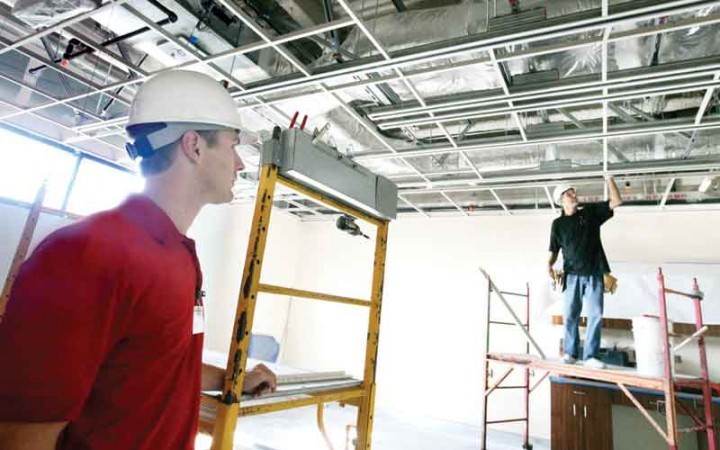
SEBASTIAN – Sebastian River Medical Center is building a cardiac catheterization clinic, allowing the hospital to provide more cardiac services including angioplasty and stents and reduce the number of heart patients it now transfers to other hospitals.
In addition, the new unit will also allow cardiologists to implant cardiac defibrillators, pacemakers and biventrical pacemakers in patients.
“We expanding the diagnostic and intervention capabilities to treat the problems in our community,” says Emily Holliman, CEO of the center. “We hope to open the second week of April.
“We transfer hundreds of patients every year from this facility to have these procedures done,” she said. “Being able to provide this to patients in our service area without them being transferred is a significant investment in our community.”
The new unit will not add beds to the 155-bed hospital although it will have four beds for patients treated in the unit.
Cardiologist Dr. Farhat Khawaja has been at the hospital since 1975 and has seen it grow dramatically.
The new unit is a big step for the hospital, he said, and he expects it to be fully utilized.
He said the new unit will provide timely health care to heart patients and notes that with heart care “timing” is everything. He said for every 10 minutes a heart patient is not treated chances of survival decrease by one percent.
“The population is getting older and more and more of them need the services,” he said of the unit. He said when he first arrived in Sebastian the hospital transferred patients to Fort Lauderdale and later added transfers to Holmes Regional Medical Center in Melbourne.
Dr. Charles Croft, of Holmes, will direct the unit, which will be located in about 5,000 square feet of renovated and new space.
That’s a significant plus for the facility, said Khawaja, noting Croft is one of the state’s most experienced cardiac physicians.
“He was my brother’s doctor for many years,” said Khawaja. “We are very fortunate to have him.”
He said if he needed a heart procedure, he’d want Croft as his cardiologist.
Holliman said Croft is one of the most experienced cardiologists in the state when it comes to catheterizations. He said Croft has done an estimated 15,000 catheterizations in his career and about 1,100 last year.
According to Holliman, the unit had been in the planning stages for about five years. “It’s safe. It’s effective and Dr. Croft has a stellar reputation.” “We are really excited about having it open,” said Khawaja.
He estimated 370 to 400 heart patients a year currently are transferred from Sebastian and the new center should dramatically reduce that number.
“We lose a lot of time arranging for transfers,” said Khawaja.
In addition, he said the cost of an emergency helicopter flight to Holmes comes in at a staggering $12,000.
“If they are having an acute event they have to be transferred by helicopter.”
Khawaja said he feels patients in the area will take advantage of having the procedures done so close to home.
“I know our volume is going to be high,” he said, pointing to the age of the medical center’s market.
The cardiologist said the huge Barefoot Bay community just north of the Sebastian River will likely be a source of a lot of patients. He estimated that most of the residents have heart and artery problems.
“This will be a great service for those people,” he said.
Holliman said when she gave a presentation at Barefoot Bay recently, a lot of people in the community’s recreation center were aware of Croft and his reputation. They greeted his involvement in the new unit enthusiastically, she said.
In addition to providing services, both Holliman and Khawaja said the trickle-down effect will benefit patients’ families because elderly spouses won’t have to make the trips to other hospitals. The new unit will be convenient for both families and patients and reduce costs.
“We’ll be doing a great service for our population,” said Khawaja.
Although the hospital does not have a cardiac surgery center, Khawaja said, patients considering having procedures done in the cardiac unit should feel confident in the treatment they’ll get.
He pointed to a number of recent studies that indicate that patient mortality is no greater at cardiac units without on-site surgery capabilities.
“The mortality is similar or lower in centers without on-site surgery,” said Dr. Nadeep Singh, a Mayo Clinic physician and author of an analysis published in the Journal of the American Medical Association.
“This is important because these centers are community hospitals where we’re promulgating an approach for easier access to these patients where “time is muscle” and there may not be a big tertiary-care hospital they can go to,” Singh added.
“Safety was a great concern for us,” Khawaja said, adding that is why the hospital is so pleased to have Dr. Croft with the unit.
“For someone with chronically blocked arteries,” said Khawaja, “it is very safe to have that procedure done in our hospital.
“I know our volume is going to be high,” Khawaja said, adding that the facility should see about 1,000 procedures a year when it is up and running.
The bottom line, Khawaja said, for people is that if they experience cardiac symptoms they need to call 911.



